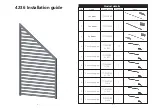
EM 122
Locating the transducer array
The location of the system’s transducer is vital for the operational performance and there
are some important guidelines which are generally applicable.
The boundary water layer
The upper water layers of the sea contain a myriad of small air bubbles created by
breaking waves. In heavy seas the uppermost 5-10 metres may be air-filled, with the
highest concentrations near the surface. Air bubbles absorb and reflect sound waves, and
may in the worst conditions block sound transmission totally.
When a vessel moves through the sea, the friction between the hull and the water creates
a boundary layer. The thickness of the boundary layer depends upon the vessel speed
and the roughness of its hull. Any objects protruding from the hull, and any dents in the
hull, will disturb the flow and increase the thickness of the boundary layer. The flow
in this boundary layer may be laminar or turbulent. A laminar flow is a nicely ordered,
parallel movement of the water. A turbulent flow has a disorderly pattern, full of eddies.
The boundary layer increases in thickness when the flow goes from laminar to turbulent.
Furthermore, air bubbles in the sea water are pushed down below the hull and mixed into
the boundary layer. The boundary layer is thin underneath the forward part of the vessel,
and increases in thickness as it moves aftwards. If the sides of the hull are steep, some
of the air bubbles in the boundary layer may escape to the sea surface along the vessel
sides. It is our experience that a wide and flat bottom, with a rising angle less than about
13 degrees athwarthship, is prone to cause air problems for a transducer.
Sketch of boundary layer underneath the vessel
on page 21 shows in principle the
boundary layer of a vessel moving through the water.
The conclusion is that the transducer array should be mounted as deep as possible, and
in the forward part of the hull.
Propeller noise
The propulsion propeller is the dominant noise source on most vessel types. The noise
is transmitted through the sea water, and may in extreme cases reduce the maximum
range capability of the EM 122.
20
317669/B
Содержание EM 122
Страница 1: ...EM 122 Multibeam echo sounder Installation Manual...
Страница 2: ......
Страница 13: ...EM 122 Figure 1 System diagram 317669 B 11...
Страница 26: ...EM 122 Figure 6 EM 122 Gondola example Cd021 107 24 317669 B...
Страница 27: ...Transducer arrays Figure 7 EM 122 blister and steel pipe arrangements example 317669 B 25...
Страница 42: ...EM 122 B B B Plastic TX protection window 40 317669 B...
Страница 46: ...EM 122 Figure 10 EM 122 Transceiver unit mounting 44 317669 B...
Страница 52: ...EM 122 Figure 13 Rear view 50 317669 B...
Страница 54: ...EM 122 Figure 15 Preamplifier Unit mounting 687 52 317669 B...
Страница 60: ...EM 122 Figure 18 Remote Control Junction Box outline dimensions 58 317669 B...
Страница 85: ...Cable layout and interconnections Figure 32 Transceiver Unit sub racks rear view 317669 B 83...
Страница 88: ...EM 122 Figure 34 Preamplifier underneath view 86 317669 B...
Страница 97: ...Cable layout and interconnections Figure 40 EM 122 Transceiver Unit s rear panel RX 317669 B 95...
Страница 126: ...EM 122 Figure 57 Cable layout 0 5 degree TX page 1 of 2 Cd021 106 Page 1 of 2 315396 Pro03 124 317669 B...
Страница 127: ...Drawing file Figure 58 Cable layout 0 5 degree TX page 2 of 2 Cd021 106 Page 2 of 2 315396 Pro03 317669 B 125...
Страница 128: ...EM 122 Ice window Figure 59 TX Ice window 126 317669 B...
Страница 129: ...Drawing file Figure 60 RX Ice window 317669 B 127...
Страница 131: ...Drawing file Preamplifier Unit Figure 62 RX Preamplifier Unit internal cabling 317669 B 129...
Страница 132: ...EM 122 Figure 63 RX Preamplifier Unit internal cabling 130 317669 B...
Страница 154: ...2013 Kongsberg Maritime...
















































